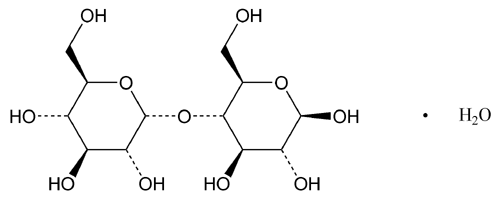Maltose
» Maltose is a sugar. It contains one molecule of water of hydration or is anhydrous. It contains not less than 92.0 percent of maltose, calculated on the anhydrous basis. The amounts of other sugars, if detected, are not included in the requirements or the calculated amount under Other Impurities.
Packaging and storage—
Preserve in well-closed containers. No storage requirements specified.
Identification—
A:
Add 2 to 3 drops of a solution of Maltose (1 in 20) to 5 mL of hot alkaline cupric tartrate TS. A red precipitate is formed.
B:
The retention time of the major peak in the chromatogram of the Assay preparation corresponds to that in the chromatogram of the Standard preparation, as obtained in the Assay.
pH  791
791 —
Prepare a 1 in 10 solution in carbon dioxide-free water. For the anhydrous form, it is between 3.7 and 4.7; and for the monohydrate form, it is between 4.0 and 5.5.
—
Prepare a 1 in 10 solution in carbon dioxide-free water. For the anhydrous form, it is between 3.7 and 4.7; and for the monohydrate form, it is between 4.0 and 5.5.
Water, Method I  921
921 —
The anhydrous form contains not more than 1.5%. The monohydrate form contains not less than 4.5% and not more than 6.5%.
—
The anhydrous form contains not more than 1.5%. The monohydrate form contains not less than 4.5% and not more than 6.5%.
Residue on ignition  281
281 :
not more than 0.05%, determined on a 2-g portion, accurately weighed.
:
not more than 0.05%, determined on a 2-g portion, accurately weighed.
Heavy metals, Method I  231
231 :
not more than 5 µg per g.
:
not more than 5 µg per g.
Dextrin, starch, and sulfite—
Dissolve 1.0 g of Maltose in 10 mL of water, and add 1 drop of iodine TS: a yellow color develops. Then add 1 drop of starch TS to this portion: a blue color develops.
Assay—
Mobile phase—
Use degassed water.
Resolution solution—
Dissolve accurately weighed quantities of maltotriose, maltose, and glucose in water to obtain a solution having concentrations of about 10 mg of each per g.
Standard preparation—
Dissolve an accurately weighed quantity of USP Maltose Monohydrate RS in water to obtain a solution having a concentration of about 10 mg per g. Calculate the exact concentration on the anhydrous basis.
Assay preparation—
Dissolve about 0.10 g of Maltose, accurately weighed, in water, and dilute with water to about 10 g. Accurately record the final solution weight, and mix thoroughly.
Chromatographic system (see Chromatography  621
621 )—
The liquid chromatographic system is equipped with a refractive index detector maintained at a constant temperature of about 40
)—
The liquid chromatographic system is equipped with a refractive index detector maintained at a constant temperature of about 40 , and a 7.8-mm × 30-cm column that contains packing L58 (see Chromatography
, and a 7.8-mm × 30-cm column that contains packing L58 (see Chromatography  621
621 ). The column temperature is maintained at about 80
). The column temperature is maintained at about 80 , controlled to within ±2
, controlled to within ±2 . Chromatograph the Resolution solution, and record the peak responses as directed for Procedure. Adjust the flow rate to about 0.35 mL per minute so that the resolution, R, between maltotriose and maltose is not less than 1.6. Chromatograph the Standard preparation, and record the peak responses as directed for Procedure: the relative retention times are about 0.9 for maltotriose, 1.0 for maltose, and 1.2 for glucose; and the relative standard deviation for replicate injections is not more than 2.0%.
. Chromatograph the Resolution solution, and record the peak responses as directed for Procedure. Adjust the flow rate to about 0.35 mL per minute so that the resolution, R, between maltotriose and maltose is not less than 1.6. Chromatograph the Standard preparation, and record the peak responses as directed for Procedure: the relative retention times are about 0.9 for maltotriose, 1.0 for maltose, and 1.2 for glucose; and the relative standard deviation for replicate injections is not more than 2.0%.
Procedure—
Separately inject equal volumes (about 20 µL) of the Standard preparation and the Assay preparation into the chromatograph, record the chromatograms, and measure the responses for the major peaks. Calculate the percentage of Maltose on the anhydrous basis, taken by the formula:
[10,000(CS / CU)(rU / rS)]/(100 – W)
in which CS is the concentration, in mg per g, on the anhydrous basis of USP Maltose Monohydrate RS in the Standard preparation; CU is the concentration, in mg per g, of Maltose in the Assay preparation; rU and rS are the peak responses obtained from the Assay preparation and the Standard preparation, respectively; and W is the percentage obtained in the test for Water.
Auxiliary Information—
Please check for your question in the FAQs before contacting USP.
Chromatographic Column—
| Topic/Question | Contact | Expert Committee |
| Monograph | Robert H. Lafaver, B.A.
Scientist 1-301-816-8335 |
(EM105) Excipient Monographs 1 |
| Reference Standards | Lili Wang, Technical Services Scientist 1-301-816-8129 RSTech@usp.org |
USP32–NF27 Page 1278
Pharmacopeial Forum: Volume No. 31(3) Page 815
Chromatographic columns text is not derived from, and not part of, USP 32 or NF 27.

